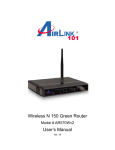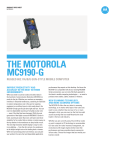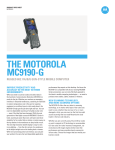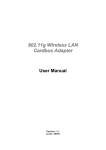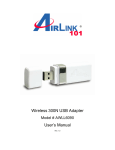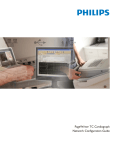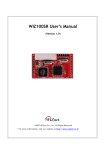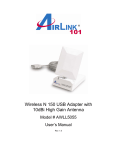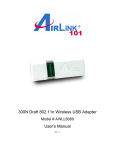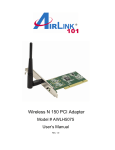Download AirLink AWLL5099
Transcript
Wireless N 150 Ultra Mini USB Adapter Model # AWLL5099 User’s Manual Rev. 1.0 1 Table of Contents 1. Introduction.....................................................................................................................................3 1.1 Package Contents ......................................................................................................................3 1.2 Features .....................................................................................................................................3 2. Install Wireless USB Adapter.........................................................................................................4 3. Connect to Wireless Network .........................................................................................................7 4. Wireless Monitor ..........................................................................................................................12 4.1 General....................................................................................................................................12 4.2 Profile Settings........................................................................................................................13 4.3 Available Network ..................................................................................................................15 4.4 Status.......................................................................................................................................16 4.5 Statistics ..................................................................................................................................17 4.6 Wi-Fi Protected Setup (WPS compatible) ..............................................................................18 4.7 Configuring Encryption ..........................................................................................................23 4.8 Ad-hoc and Peer-to-Peer Wireless Networks .........................................................................27 4.9 Access Point Mode .................................................................................................................30 4.10 Virtual Wi-Fi mode...............................................................................................................35 4.11 About.....................................................................................................................................40 5. Troubleshooting ............................................................................................................................41 Appendix A - Specification ..............................................................................................................42 Technical Support .............................................................................................................................44 2 1. Introduction Congratulations on your purchase of the Wireless N 150 Ultra Mini USB Adapter! Its high bandwidth combined with extended wireless coverage delivers fast and reliable connection for all of your networking applications. The adapter will yield a higher throughput especially when it is used with other Airlink101® Wireless N products. A full range of security features WEP, WPA-PSK, and WPA2-PSK provide you the highest level of wireless network security. The bundled wireless utility Airlink101 Wireless Monitor allows you to set up the adapter with an easy-to-use user interface. The Wireless N 150 Ultra Mini USB Adapter works with 802.11 b/g/n network devices to ensure compatibility with your existing wireless products. 1.1 Package Contents Before you begin the installation, please check the items of your package. The package should include the following items: • Wireless N 150 Ultra Mini USB Adapter • • Quick Installation Guide Installation CD (Driver/Utility/Manual) 1.2 Features • • • • • • • • • • • Supports IEEE 802.11b/g/n Built-in Easy Setup Button for easy connection to the existing wireless network WEP, WPA2-PSK and WPA-PSK enhanced wireless security to provide a full protection for your wireless network Super mini size and compact design for greater flexibility Compatible with Windows 7/Vista/XP, MAC OS 10.4/10.5/10.6 Fully backward compatible with 802.11b/g network devices Software AP function support on Windows XP and Vista Supports WoW and Dual Core IEEE 802.11 b/g Ad-hoc Roaming Supports Japan Mid Band 3 2. Install Wireless USB Adapter This section provides instructions on how to install the Wireless N 150 Ultra Mini USB Adapter. The driver is installed along with the utility. Step 2.1 Insert the USB adapter into an available USB port of your computer. Step 2.2 Click Cancel when you see the Found New Hardware Wizard. Windows XP/2000 Users: Windows 7/Vista Users: 4 Step 2.3 Insert the Installation CD in the CD ROM drive. The Autorun screen will pop up. Select Install Utility and Software from the menu. Note: If the Autorun screen doesn’t appear automatically, go to Start, Run, and type D:\Utility\Setup.exe (where D is the letter of your CD ROM drive) and click OK. Windows 7 or Vista Users: When you get warning message(s), make sure that you give permission to continue with the installation of the driver software. Step 2.4 Click Next to begin the installation. 5 Step 2.5 For Windows 7/Vista: click on Run Autorun.exe. Please wait for Windows to finish installing the driver and the Utility(“Airlink101 Wireless Monitor”). Step 2.6 Select Yes, I want to restart my computer now. Click Finish to complete the installation. The driver and utility have been installed. Please continue to the next section. 6 3. Connect to Wireless Network This section describes how to connect your wireless USB adapter to a wireless network. Step 3.1 Open the Airlink101 Wireless Monitor utility by double clicking on the Airlink101 Wireless Monitor Utility icon in the system tray at the bottom right-hand corner of your screen. Step 3.2 The Easy Setup Button(WPS compatible button) is a new and easy way to configure the encryption for your wireless network clients, it is Wi-Fi compatible. In order to use it, you need to have a router that supports this feature. If your router doesn’t support Easy Setup Button function, continue to Step 3.4. 1. Push the Easy Setup Button of the Adapter until you see the following window pops up on the monitor. 7 This window pops up to acknowledge you the Adapter is starting to establish a connection. 2. Within the following 2 minutes, push the Easy Setup Button (WPS compatible button) of the Router. The picture below shows Airlink101 AR685W Wireless N Green Router. 3. The router will now start to synchronize the encryption settings with the wireless USB adapter. The connection will be established in 1 minute. Continue to Step 3.5. Note: For some cases for the WPS button on the routers to be pushed first before the one on the adapter. If the connection is not able to establish, continue to Step 3.3. 8 Step 3.3 Click the Available Network tab of the Wireless Monitor, select the SSID (Network Name) of the wireless network that you wish to connect to, and click Add to Profile. If the network that you are attempting to connect does not have encryption enabled, you will receive a warning about connecting to an unsecured network. Click OK to complete the connection. 9 Step 3.4 Enter the wireless security key into the Network Key box if the network you are attempting to connect has wireless security enabled. Click OK. The Adapter will automatically detect the type of Network Authentication and the Data encryption. All you need to do is to enter the Network Key in the appropriate boxes according to the settings of the wireless router and then click OK to connect. 10 Step 3.5 The connection should now be established. Go to the General tab to check the status of the connection. Verify that IP Address, Subnet Mask and Gateway have valid numbers assigned to them (instead of all 0’s). The Status should be Associated, and there will be green bars next to Signal Strength and Link Quality. Congratulations! You have now connected to the wireless network succefully. 11 4. Wireless Monitor This section describes the various functions of the Wireless Monitor that you can configure, including the settings of wireless encryption. 4.1 General The General tab provides you with the status of the current connection, including signal, network name (SSID) and IP Address. At the bottom, you have options for controlling the utility and adapter. Show Tray Icon allows you to show or hide the tray icon for the utility. Radio Off disables the wireless function of the adapter. Disable Adapter completely disables the wireless adapter. 12 4.2 Profile Settings The Profile tab lists the current profiles and allows you to add/remove/edit profiles. The Available Profile(s) box lists all the profiles that you’ve created for your network. A profile is automatically created and added to this list when you connect to a new network. You can also manually add a profile. To modify an existing profile, select the profile from the Available Profile(s) box and click on Edit. The Profile box will pop up, allowing you to modify the settings for this profile. To create a new profile, click on Add. The Profile box will pop up, allowing you to specify the settings for your new profile. 13 Enter the profile settings here, including Profile Name, SSID, Network Authentication, Data Encryption and Network Key. Click OK to save the changes. In section 4.7, Configuring Encryption will give you the information of how to configure the different options of the wireless network encryption settings. 14 4.3 Available Network The Available network tab lists all of the wireless networks that the adapter detects in your area. Clicking Refresh will scan for available wireless networks and refresh the list. To connect to a network, select a network from the list and click Add to Profile. 15 4.4 Status The Status section provides you with a list of information about the current status of the adapter. 16 4.5 Statistics The Statistics section provides you information about transmitting and receiving packet counts. 17 4.6 Wi-Fi Protected Setup (WPS compatible, Easy Setup Button) The Wi-Fi Protected Setup is a new and easy way to configure the encryption for your wireless network clients. In order to use it, you need to have a router that supports this feature, like the AR685W Airlink101 Wireless N Router. You also need to configure the wireless encryption on the router; you should find the instructions of how to configure it in the router’s user manual. If your wireless router does not support this feature, you will need to set up the wireless encryption manually and you can skip this section. We are using the Wireless N 150 Ultra Mini USB Adapter and the AR685W Airlink101 Wireless N Green Router to illustrate the following setup instructions. Step 4.6.1 Open the Airlink101 Wireless Monitor. Click on the Wi-Fi Protect Setup tab. Choose your configuration method: - For Push Button method, click Push Button Config (PBC) button, continue to Step 4.6.2 - For Pin Input Config method, click Pin Input Config (PIN) button, continue to Step 4.6.3a 18 Step 4.6.2 When you see this window will pop up, push the Easy Setup Button(WPS Button) on the router and hold for 3 seconds. The router will now start to synchronize the security settings with the wireless USB adapter. The connection will be built up within 1 minute. 19 Step 4.6.3a If you choose the Pin Input Config method, click Yes when prompted with the question “Do you want to select a specific AP?” Select the Access Point that you want to connect to, and then click Select. Write down the PIN Code on a piece of paper. 20 Step 4.6.3b Log on to your router’s configuration page from the web browser and click on Wireless. Then click WPS. Step 4.6.3c Make sure that the Disable WPS is NOT checked. Enter the Pin Code in the Client Pin Number box and click Start PIN. 21 After a few moments, both the router configuration screen and the adapter configuration screen should show a message telling you that a connection is established. Note: If you cannot connect successfully with WPS, you need to log in to your router’s configuration and click on Wireless, then click WPS. Make sure that the Disable WPS box is NOT checked. 22 4.7 Configuring Encryption This section describes the available encryption types and how to configure them. In most cases, encryption type will be automatically detected by the wireless USB adapter; all you need to do is to enter the Network key, as described in Section 3, Step 3.4. If you are creating a custom profile, you need to manually configure the encryption settings. The encryption settings you configure must match the settings on the AP or wireless router you wish to connect to. Please follow the instructions below. Open the Wireless Monitor utility, click Profile tab and then click Add. The available options of wireless network encryption settings are: Disable: No encryption in use WEP: The most popular but least secure form of encryption (Open System/Shared Key) WPA/WPA2-PSK: The most secure and recommended level of encryption 23 4.7.1 Configuring WEP Encryption Select WEP from the Data encryption box. Under Network Authentication, select either Shared key or Open System, according to the router settings. If your WEP key is 5 or 13-digit, or alphanumeric : • Check ASCII and enter your WEP key into the box next to PASSPHRASE If you use Passphrase to setup the WEP encryption for your router : • Check PASSPHRASE and enter your key into box next to PASSPHRASE. If your WEP key is 10 or 26-digit, hexadecimal (0~9, A~F) : • Select the Key Index (It is the key of the router that is currently in use). Enter the network security key that matches the one on the router into Network key and Confirm network key boxes. Click OK to save your settings. 24 4.7.2 Configuring WPA/WPA2-PSK Encryption (for home users) Select WPA-PSK/WPA2-PSK from the Network Authentication box. In Data encryption box, select either AES or TKIP depending on the settings of your router. Enter the encryption key that the router is using into the Network Key and Confirm network key entries. Click OK to save your settings. 25 4.7.3 Configuring WPA/WPA2/WEP Encryption (for corporate networks) Select WPA 802.1x / WPA2 802.1x / WEP 802.1x from the Network Authentication box. In Data encryption box, select AES, TKIP or WEP depending on the settings of your router. Select different EAP type among GTC, TLS, LEAP, TTLS and PEAP. Please refer to your system administrator for information about what settings you should enter here. Click OK to save the settings. 26 4.8 Ad-hoc and Peer-to-Peer Wireless Networks Ad-hoc networking is used when you want to connect two or more computers together without connecting to a router. In ad-hoc mode, only certain features that come with a router are available. The maximum connection speed drops to 11Mbps. In addition, WEP encryption is the only encryption type available in Ad-hoc mode. To set up Ad-hoc mode, you will need to create a new profile. Open the Wireless Monitor. Click on Profile, and then click on Add; the profile settings menu will pop up. 27 First, change the network type to Ad-hoc by checking “This is a computer-tocomputer (ad-hoc) network; wireless access points are not used”. Enter a network name (SSID) into the SSID box and select the desired Channel. In Data encryption pull-down menu, select Disabled or WEP encryption. If you choose WEP encryption, please refer to the instructions in Section 4.7.1 Configuring WEP Encryption. Then, click OK to save the profile. 28 Once that is done, click on the Available Network. Select the new profile from the Available Network(s) box, and double click to enable it. You need to configure all other computers that you are planning on connecting to your Ad-hoc network with the same settings that you input for the Ad-hoc network. Every computer has to be set up exactly the same. If any of the settings are different, the network will not function. Note: If you are having trouble connecting, slow connection, or connection is unstable, you need to try changing channels. Start with channel 1 and up until you find a channel that gives you the best signal reception. If the channel is changed, please save the settings, and then reboot the computer. Also, make sure that you do this on every Ad-hoc machine so that they will all be synchronized to the same channel. 29 4.9 Access Point Mode In Access Point mode, it allows you to set up your computer as a wireless router and share its existing internet connection with other computers. In order to use this mode, the computer needs to be hard wired directly to the internet. To switch the adapter into Access Point mode, click on Mode in the menu bar and select Access Point. Then, an icon will appear in the system tray icon as shown below: 30 And the below window will pop up with new setting options: 4.9.1 General SSID displays the current SSID setting of the adapter. The SSID is what the other computers will need to roam for when trying to connect to this adapter. BSSID is the physical address or MAC address of this wireless adapter. Association Table shows the remote computers that are currently connected to this wireless adapter. Click on Config to view other available settings: 31 In this window, you can configure all the settings for your adapter. Network Name(SSID) this is the name for the network that your wireless adapter will be broadcasting. Channel allows you to select the channel that you want the network to operate on. You may want to change this if you are having signal reception issues. Wireless Network Security allows you to set up encryptions for your network. Please refer to Section 4.7 Configuring Encryption for details. 32 4.9.2 Advanced Settings The Advanced tab provides settings for Beacon Interval, DTIM Period, and Preamble Mode to fine tune the adapter’s connection. Click apply after making changes for the settings to take effect. To restore the settings, click on Set Defaults, and then click Apply. 4.9.3 Statistics This shows you the statistics about your network. 33 4.9.4 ICS ICS(Internet Connection Sharing) shows all the wireless clients that are sharing the internet connection provided by the adapter. This is automatically configured during the setup. Select the client in the list and click Apply. 34 4.10 Virtual WiFi Mode In Virtual WiFi mode, it helps a user to connect his/her computer to multiple 802.11n wireless networks. The adapter can simultaneously acts as a client connecting to an AP and also as an AP allowing other clients to connect to it. To switch into Virtual WiFi mode, click on Mode in the menu bar and select Virtual WiFi. 35 The adapter can join other APs as a client. The procedure is the same as explained under Section 4.9. 36 The Soft AP function can be turned on by checking the Virtual WiFi Soft AP box under the Virtual WiFi tab. 37 The AP configuration and encryption can be set up as described above under section 4.7. 38 ICS is configured by checking the Setting Internet Connection Sharing box. The public network to share internet connection is automatically chosen by the utility. If you need to specify the network, uncheck the Auto Select Public Network box and choose the required network interface from the drop down list and click Apply button. 39 4.11 About Click on the About(A) tab in the menu bar to show the Airlink101 Wireless Monitor and driver version. 40 5. Troubleshooting 1. If you cannot open the Wireless Monitor utility, make sure that the USB adapter is inserted firmly into the USB port. 2. If you cannot connect to the wireless router, you may read to double check the wireless security settings on the router. The network key you entered in Step 3.4 must match the settings on the wireless router. 3. If you are experiencing problems with the connection such as low signal strength, slow connection speed, or unstable wireless connection, you can try to tune your router’s signal by changing the channels on the router and/or by adjusting the direction of the antenna(s). You do not need to change the channel on the Adapter; it will automatically pick up the new channel after you reboot the router. Your router has 11 different channels to choose from. Keep going through the channels until you find one that gives you a stable connection. For instructions on changing channels, please refer to the documentation that comes with the router. 41 Appendix A - Specification Frequency Band • 2.4~2.5 GHz Standards • IEEE 802.11b / 802.11g/ • IEEE 802.11n Media Access Protocol • CSMA/CA Operating Channels • 1 – 11 (U.S. & Canada), 1 – 13 (available depending on local regulation); 1 – 14 (Japan) Interface • USB 2.0 Access Methods • Infrastructure, Ad-hoc(802.11 Ad-hoc) and Roaming Security • WEP,TKIP,AES-CCMP,WPA-PSK,WPA2-PSK,802.1x, , EAP-TLS,EAP-TTLS,PEAP(EAPGTC),PEAP(EAP-MSCHAPv2), WPS compatible Transmitted Power • 802.11b: 18 dBm Max. • 802.11g: 18 dBm Max. • Draft 11n: 18 dBm Max. Data Rate • Transmitting: Up to 150Mbps* • Receiving: Up to 150Mbps* System Requirements • 300 MHz processor or better • 512Byte RAM • Available USB port QoS • 802.11e, WMM Software AP for XP and Vista • WEP(64 and 128 bits) 42 • • MAC address filter(Access or Reject List) ICS setting on XP and Vista OS Compatibility • Windows 2000 / XP(32&64bit) / Vista(32&64bit) / 7(32&64bit) • MAC OS 10.4/10.5/10.6 Dimensions • 20 x 14 x 8 mm (L x W x H) Temperature • Operating: 0ºC to 55ºC • Storage: -20ºC to 70ºC Humidity • Operating: 10% to 80% Non- Condensing • Storage: 5% to 90% Non- Condensing Warranty • Limited 1-year warranty Safety Approvals • FCC, CE, IC 43 Technical Support E-mail: [email protected] Toll Free: 1-888-746-3238 Web Site: www.airlink101.com *Theoretical maximum wireless signal rate derived from IEEE standard 802.11 specifications. Actual data throughput will vary. Network conditions and environmental factors, including volume of network traffic, building materials and construction, mix of wireless products used, radio frequency interference (e.g., cordless telephones and microwaves) as well as network overhead lower actual data throughput rate. Compatibility with draft 802.11n devices from other manufactures is not guaranteed. Specifications are subject to change without notice. Photo of product may not reflect actual content. All products and trademarks are the property of their respective owners. Copyright ©2011 Airlink101® 44













































